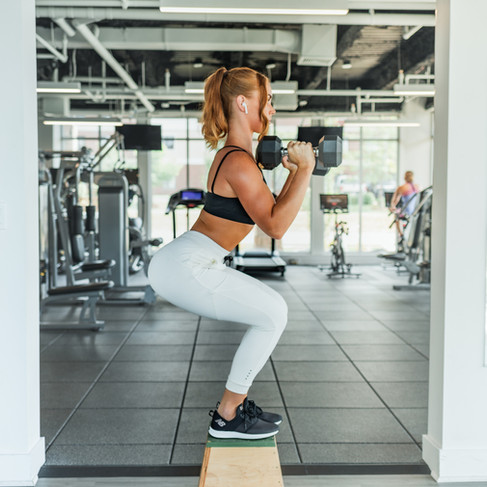
The spine is a pretty cool design. There are 7 vertebrae in the cervical spine, 12 in the thoracic spine (matching the ribs), 5 vertebrae in the lumbar spine, and some fused vertebrae that make the sacrum at the bottom. Even though it is labeled as different sections, it is one continuous spine. With the corresponding discs, the vertebrae give us so many options for movement including flexion, extension, side bending, rotation, and some shearing.
In the efficient state, the vertebrae move in an even arching motion, much like this little bridge:

You can imaging if one part of this bridge didn't move so well to create this arching shape or if one part moved too much, there would be uneven weight distribution throughout the structure. Ultimately, the bridge would start to have issues.

Granted, our spines aren't bridges. Unless you have a toddler in which your own body feels like many things. Spines are columns that take on the force from gravity. Connected to our spine are 4 ball-and-socket joints, 2 hips and 2 shoulders. Technically, they are connected via the pelvis and scapula but we are thinking broadly here. Due to their design, they allow many options for range of motion. With our shoulders, we are able to reach in all sorts of directions above, below, behind, and in front of us. With the proper movement strategy, we are able to hinge or fold into our hips to squat, sit, jump, and lunge. Our spines are compromised of segments of bony vertebrae with discs in between, which are supported by ligaments, fascia, and musculature. That joint design does not make a good hinge...and yet areas of the spine get treated like one. That's when we may develop herniated discs or stenosis, which is when the space where the nerve root exits becomes quite narrow. Too much strain in the same direction may also result in spondylolisthesis, which is when the vertebrae starts to slip away from its neighbors. It's kind of like this stack of pumpkins. Imagine each pumpkin in a vertebral segment. See how the first two have become hinge-like? If you drew a plum line down the center of this stack, it is clear that the left side of those top two vertebral segments get much more load bearing from gravity than the right side. The ligaments on the right side would get overstretched.
Before you panic thinking that your spine is probably a tumbly stack of pumpkins, let me make this statement very clear: herniated discs, stenosis, and arthritis are a part of the normal wear and tear of life. If you ever get imaging on your spine and the results say "mild ____", that is a guaranteed finding if you are over the age of 20 years old. We age on the inside just as we do on the outside. Sure, there are things that can speed this process up, such as genetics, poor movement strategies, poor nutrition, excess alcohol intake, poor sleep, little exercise, chronic poor stress management, and hormone issues, to name a few. Also, the findings on x-ray might not even be the source of your pain. That's for another blog post.
There are areas of the spine that are very common targets for "hinge points". Starting from below, the lowest vertebral segments L4-L5 or L5-S1 are common areas for strain. There are many potential reasons for why this happens. As you can see in the picture below, an anterior pelvic tilt changes the plum line trajectory (imagine this as the force of gravity) to go through more of the posterior lumbar spine (especially in those lowest segments) than through the middle of the vertebral body like it does with good posture. Weak lower and deep abdominals accompany this pattern. A poor sitting posture of weightbearing on the tailbone and sacrum is very compressive to the spine. Decreased hip extension (when the leg is behind you) can also make us hinge at our lumbar spine to make up for lost range of motion. This may come up as low back pain while walking, running, and standing.
Using this same picture, another area of common strain is C7-T1, which is the last cervical vertebrae and the first thoracic vertebrae. If you run your fingers down the back of your neck, you eventually get to a big bump at the very bottom. That is the spinous process of T1. With a forward head posture, you often see a "step off" from T1 to C7. This means when you are touching T1 and you run your fingers up towards your head, you would feel like there is a big drop off from T1 to the segment above it. If you look at the plum line of the poor posture, the force of gravity goes straight to that lower cervical spine, where C7 and T1 meet. With this, you also have weak deep neck flexors, known as the "core" of the neck. See a trend here?
Poor movement strategies may also get our spine into a hinging pickle. For some, reaching overhead is accomplished by arching the back, often hinging at T12-L1, or the lowest part of the thoracic spine and the highest part of the lumbar spine. In the efficient state, your lower ribcage should be flush with your abdomen (this would be the neutral position). This position should stay that way while reaching overhead but for many, the lower ribs are flared and tipped backward, extending the spine. A squat is another good example. When returning to upright from the squat position, the power should be initiated from the legs, as if you were doing a leg press into the floor. If the movement is initiated by the low back extending more or the head rising up first, than the lumbar or lower cervical spine is taking on a lot of work and that's not a good thing.
The picture on the left is beautiful! His back is in neutral and he is hinging at his hip joints. The picture on the right hurts me inside! There is a lot of low back extension here.
So what to do? Our spines love length. May people love inversion tables because of the lengthening sensation they get. This is a great tool for managing symptoms but it's even more important to be able to actively lengthening your spine. The familiar cue of, "Lengthen the back of your neck gently like a string is pulling the back of your head towards the ceiling, settling your chin towards your throat." comes to mind. You can take it a step further and lengthen the back of your neck while you lengthening your lumbar spine, letting your tailbone become heavy (not tucked!). My favorite visual is to imagine you are settling your 20 ft. dinosaur tail onto the ground. Take many breaks from sitting if you have a sedentary lifestyle or job. The latest research recommends moving for 5 minutes after every 30 minutes of sitting. Get your deep core in your neck and abdominals strong and think about this as a lifetime of maintenance. If you don't know what that is, check in with a physical therapist to learn. Hint: it's not crunches. Have a PT, coach, or a trainer watch you perform different movements, especially ones that cause you pain. Heck, you can even record yourself on your phone and see what you may notice. I love when people bring their videos and pictures into the clinic. For feedback, I often use patient's phones to show them what I'm seeing. What did we do before cameras were on our phones?!
Movement through our spine is healthy and encouraged. But repetitive faulty movements with an added load of gravity or resistance plus a weak deep core system is asking for trouble. It takes a lot of learning new habits, unlearning old ones, awareness, and practice. Your spine will be happy!






Comments